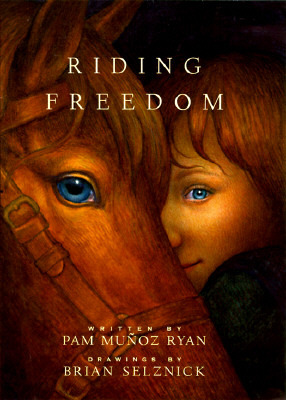 Riding Freedom
Riding FreedomPam Munoz Ryan
Brian Selznick, Illustrator
Scholastic, 1998 138 pages
Grades 3-6
Historical Fiction
Charlotte Parkhurst is an orphan living in New England in the mid-eighteen-hundreds. Even though she loves horses and has a natural way with them, because she is a girl she must work as a servant in the kitchen with a horribly mean cook. After being forbidden to help out in the stables in her spare time and ride her beloved horses, followed by her best friend being adopted, Charlotte decides to run away. But how? It is not safe or practical for girls to try to strike out on their own. Charlottes changes her name to Charlie, dons boy’s clothes, borrows money from the ex-slave stable-hand who is her friend and sets off to seek her fame and fortune. Naturally, Charlie lands at a stable, where she proves to be an excellent hand, working herself up the ranks to stagecoach driver. The owner of the stables suspects Charlie's true identity, but chooses to kindly allow her to remain in his employ and keeps her secret. An opportunity in California sees Charlie relocating and getting closer to her dream of owning her own stable, only to lose her eye after being kicked by a horse. Her stage coach driving days seem over, yet Charlie does not give up. She learns to drive the coach with one eye, increasing her reputation and finally reaching her lifelong dream. Her old orphan friend and previous boss come to stay at her new stables and Charlie at last seems happy and at peace. Another dream is realized as Charlie becomes the first woman to vote in the United States in 1868. Although voting as a man, Charlie proves that women can make intelligent decisions in politics, paving the road for future generations.
There are very few historical fiction choices for younger chapter readers that do not involve time travel. Riding Freedom is one of my favorites. It is an excellent choice for historical fiction projects, strikes a blow at discrimination based on gender and race, and is an all-around great story. Ryan jams non-stop action into the 138 pages, tracing the life of this little-known American woman. Charlie demonstrates courage, tenacity, and sheer pluckiness in the face of adversity. Nothing seems to keep this character down as she slowly and determinedly realizes her dreams. The colloquial language helps to place the reader in the time of the story and the setting is fully realized. Full-page pencil illustrations, drawn by the wonderfully talented Brian Selznick, can be found in every chapter and help to flesh out the tale and keep readers turning pages. Great for both classroom use and recreation, the book will be enjoyed by a broad audience and works on many levels. The print is large, the chapters are short, and the margins are wide, inviting new chapter book readers. The vocabulary is richer than most books for this audience, bringing the reading level to a deceptively higher level than this selection appears at first glance. The American frontier was not a land of opportunity for everyone. Parkhurst manages to break the constraints of her time and become an American success story and inspiration to future generations.
No comments:
Post a Comment